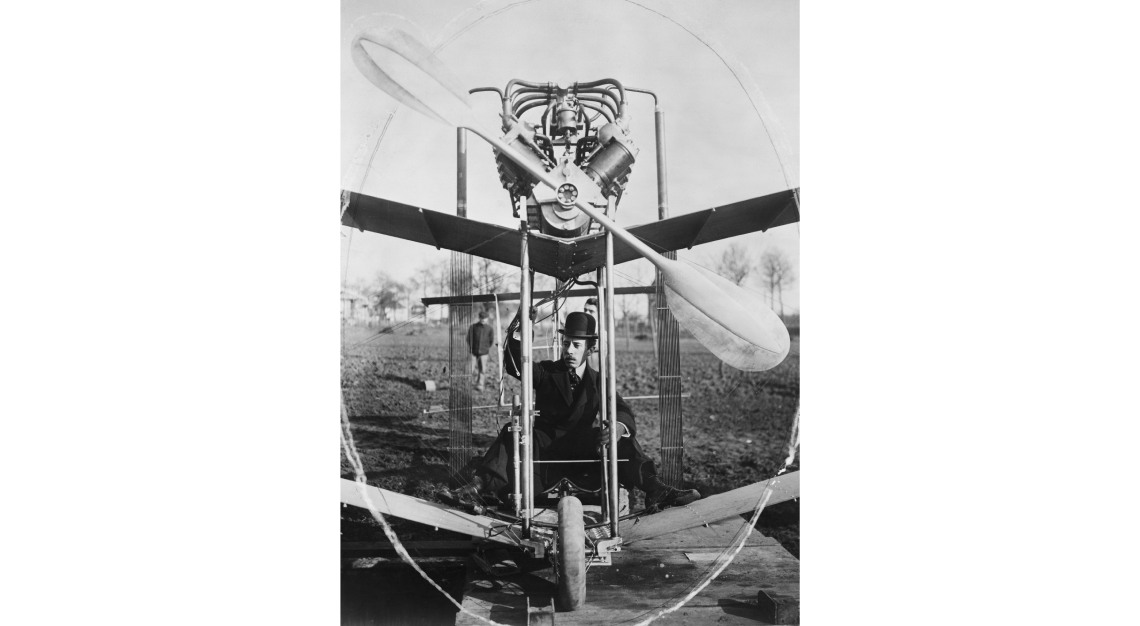Within the Cartier Santos-Dumont lies one of the most enchanting stories ever told about early aviation
One can only imagine the life led by Alberto Santos-Dumont. A national hero in Brazil, he was an aviation pioneer, an inventor and an engineer. A dapper gent, Santos-Dumont was a scion to a vast coffee empire. He was also a publisher. A designer. A trendsetter. A tastemaker. An influencer. In spite of his diminutive stature, Santos-Dumont left a huge imprint on Parisian society. Parisians knew him as Le Petit Santos and did their best to copy his style of dress which often included high-collared shirts, well-fitting jackets and that signature Panama hat.
In retrospect, Le Petit Santos was a doubly appropriate sobriquet for the aviation enthusiast. It’s one thing to be inspired by beautiful blue skies and quite another to invent something to reach for them. His father was a trained engineer who moved from France to Brazil, and somehow, somewhere, machinery began to fascinate a young Santos-Dumont. Throughout his life, he was drawn to beautiful mechanical objects, and at one point rode around on a De Dion-Bouton tricycle.

Santos-Dumont also read a lot. Jules Verne novels, in particular, fuelled his imagination and motivated him to chase his dreams. But ultimately the book that nudged him towards his destiny was entitled Andrée and His Balloons. It was an account of Swedish explorer Salomon Andrée’s attempt to reach the North Pole by balloon, as written by the balloon constructors Lachambre and Machuron, and described by Santos-Dumont as “a revelation”.
Based in Paris, Lachambre and Machuron gave Santos-Dumont all the training he needed to fly in a hot-air balloon. They also helped build his first balloon named Le Brésil. With a capacity of just 113 cubic metres, it was small, lightweight and nifty, and when fully deflated, it could even fit into a handbag. Le Brésil was the first of many flying adventures to come.
Indeed, Santos-Dumont advanced quickly from hot air balloons to dirigibles, or airships as they were also known. These were motor-powered balloons one could steer through the air. After a series of initial failures, countless design modifications and several near-death experiences, he got his first taste of success. With Dirigible No. 6, he won the first Deutsch de la Meurthe award for making it from Parc Saint Cloud to the Eiffel Tower and back in less than 30 minutes. Along with fame and recognition, Santos-Dumont received 100,000 francs, which he distributed equally among his workers and the poor. Now a proper celebrity in Paris, Santos-Dumont was constantly in the public eye. Not that he could help it, really. His preferred mode of transport soon caused a stir among the city’s fashionable set. After all, not everybody could casually hop onto an airship and float over the Parisian boulevards to land on a rooftop cafe for lunch – extravagant yet also very chic; no wonder the French loved him. No. 9 Baladeuse was one of the smaller airships he had built, like a flying car designed for urban commuting.
“The day will come when aerial omnibuses will transport tourists and business travellers,” insisted its creator.

However, Santos-Dumont was no attention-seeker. Neither fame nor fortune were the motivation behind his ambition to fly. Rather, he believed that aviation would open a new world of possibilities leading to great peace and prosperity. This was why he freely published all his designs and never patented any of his inventions.
This was also why he continued researching and experimenting, putting himself in harm’s way, long after he’d achieved his goal of flying. Beyond piloting an airship, Santos-Dumont wanted to fly faster and farther, and one simply couldn’t conquer distance and speed without time. Aviators in the early 20th century relied primarily on pocket watches to clock their performances. Not only was it a huge inconvenience, but dangerous too for a pilot to take his hands off the controls.
Which brings us to the story that in 1904 Santos-Dumont approached his good friend Louis Cartier to create a timepiece he could wear on his wrist in order to read the time without having to move his hands. Cartier responded with a robust and practical watch attached to a leather strap, creating the world’s first wristwatch for men, which also happens to be the world’s first aviation timepiece and indeed the world’s first square wristwatch.
But why did Cartier work on a square case rather than a round one, which was the obvious prevailing aesthetic of the time? There is no clear answer to this question. What we do know, however, is that the two friends were both sartorially elegant and keen aesthetes, so venturing beyond the obvious was only natural.
In addition to the square case with elegantly rounded corners, the timepiece had a square bezel featuring eight exposed screws – both features were completely atypical of the time. They secured the crystal onto the case and evoked the four legs at the base of the Eiffel Tower. As an indispensable companion in the cockpit, the Cartier Santos followed Santos-Dumont as he moved on to new territory: heavier-than-air flight.


Within two years, Santos-Dumont built his famous 14-bis and flew it at the Château de Bagatelle in Paris over a distance of 60m at a height of about five metres. For this, the Aéro-Club de France awarded him the Deutsch-Archdeacon Prize, as it more than doubled the 25m mark.
The 14-bis was also known as a ‘canard’ biplane as its architecture resembled a duck with its long neck stretched out in flight. Santos-Dumont had it constructed from bamboo and pine wood joined by aluminium sockets, and covered the box kite-like structures known as Hargrave cells in
Japanese silk. This lightweight aircraft formed the blueprint for Santos-Dumont’s next and final invention, La Demoiselle.
Unlike the 14-bis, La Demoiselle was a monoplane where the pilot sat below the wing and between the wheels of the undercarriage. Gone were the Hargrave cells, but the bamboo and Japanese silk remained. Designed to be compact and light, La Demoiselle was also relatively inexpensive to build, and thus intended for large-scale production. Needing only 15 days to construct, it popularised aviation and made it accessible to wider audiences.
“And we will sail through the air seeing Europe unfold at our feet like a geographical map,” promised Santos-Dumont. “There we will remain, suspended between the stars and the Earth.” Trusting in the spirit of innovation, Santos-Dumont shared the blueprints and specification sheets with anyone who was interested.
From a mere skyward glance, to flying in a balloon, and then becoming one of the greatest aviation pioneers the world would ever know, Santos-Dumont’s incredible life story and contribution to aviation impacted human society in ways even he couldn’t have imagined.
And he might not have been able to anticipate how much he, with the help of Louis Cartier, would come to leave such a lasting impact on 21st-century watchmaking culture, but he most certainly has.
This story first appeared in the July issue, which you may purchase as a hard or digital copy






